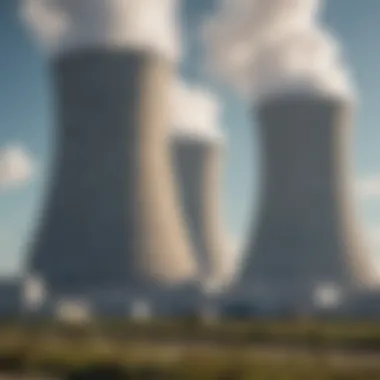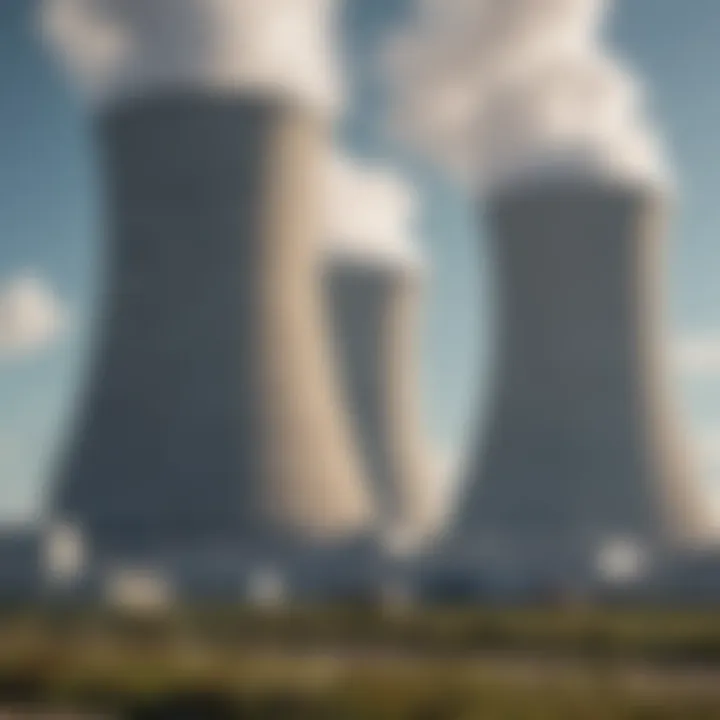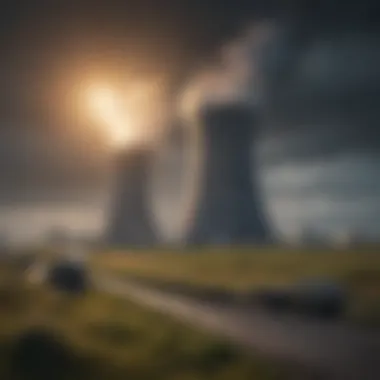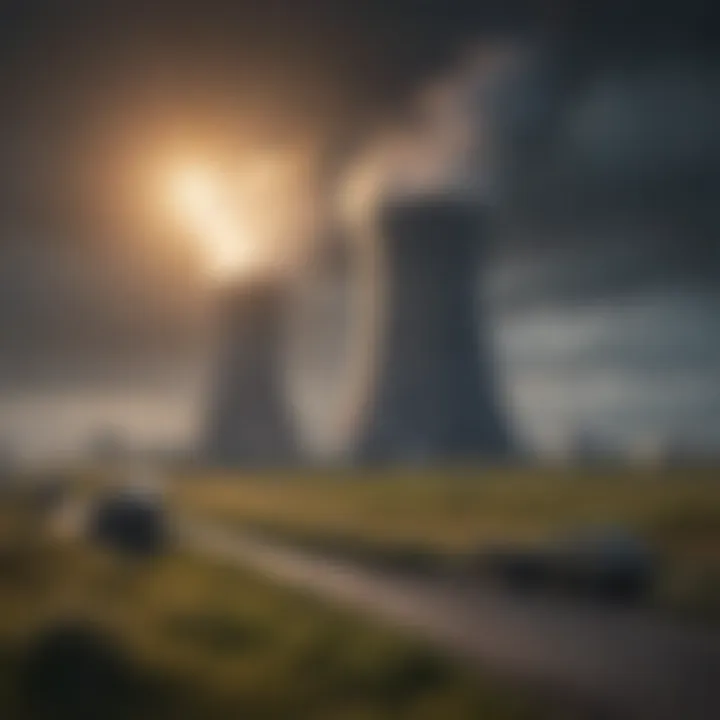Unlocking the Advantages of Nuclear Power Today


Intro
Nuclear power is often at the center of debates regarding sustainable energy. As energy demands increase globally, this form of power generation offers several benefits. Understanding these advantages can guide discussions among students, researchers, educators, and professionals seeking sustainable solutions.
In this article, we will explore the efficiencies, environmental impacts, and the economic potential of nuclear energy. Key elements include the role nuclear power plays in reducing greenhouse gas emissions, enhancing energy independence, and supporting safety technologies. These aspects are crucial, as societies aim to balance energy supply with environmental responsibility.
The conversation surrounding nuclear energy is nuanced. Therefore, we will also consider public perceptions, the implications for global energy security, and the future outlook for nuclear power. By dissecting these elements, we hope to provide a comprehensive understanding of how nuclear energy can contribute to meeting future demands.
Research Overview
Understanding the current landscape of nuclear power requires a detailed examination of recent findings. There is a growing body of research highlighting its effectiveness as a low-carbon energy source.
Summary of Key Findings
Recent studies demonstrate that:
- Nuclear energy produces minimal greenhouse gases compared to fossil fuels.
- The efficiency of nuclear plants can exceed that of solar and wind when considering land use and energy output per square meter.
- Advancements in reactor design, such as Generation IV reactors, promise enhanced safety and reduced waste.
These findings suggest that nuclear power can play a significant role in achieving sustainable energy goals.
Relevance to Current Scientific Discussions
The relevance of nuclear energy in today’s discussions on climate change cannot be overstated. As nations strive to meet emission reduction targets, the inclusion of nuclear power becomes increasingly pertinent. Discussions also focus on the socio-economic aspects of adopting nuclear energy, including job creation and energy independence.
"The future of energy security may hinge on how effectively we can integrate nuclear power into our energy mix alongside renewables."
Culmination
Through this exploration, we aim to reveal the multifaceted benefits nuclear power offers. By considering its role in emission reduction, energy independence, and technological advancements in safety, we contribute to the larger discourse on sustainable energy solutions.
Prelude to Nuclear Power
Nuclear power represents a significant component in the global energy landscape. In the context of sustainable energy solutions, its relevance continues to grow. This section will elaborate on the definition, historical context, and key attributes of nuclear power, thus setting the groundwork for further exploration of its overall benefits.
Definition and Overview
Nuclear power is a form of energy generated through the process of nuclear fission. During fission, atomic nuclei split, releasing a substantial amount of energy. This energy is harnessed to produce electricity in nuclear power plants. Unlike fossil fuels, the primary fuel source for nuclear power is uranium, which is relatively abundant. The energy density of uranium is remarkably high, meaning that even small amounts can produce significant energy, making nuclear power an efficient choice for large-scale electricity generation.
It is vital to note that nuclear power plants do not emit greenhouse gases during operation, setting them apart as a cleaner energy option compared to coal and natural gas plants. Furthermore, the advancements in reactor technology continue to enhance the safety and efficiency of nuclear power, addressing some of the historical concerns that have surrounded its use.
Historical Context
The history of nuclear power dates back to the mid-20th century. The first controlled nuclear chain reaction was achieved in 1942, during the Manhattan Project. This development marked the beginning of utilizing nuclear processes for energy production. The first commercial nuclear power plant began operation in 1956 in Calder Hall, England, and it paved the way for the expansion of nuclear energy worldwide.
Throughout the late 20th century, several countries, including the United States, France, and Japan, invested heavily in nuclear power infrastructure. Nuclear energy quickly gained popularity due to its ability to provide large amounts of electricity without the carbon emissions associated with fossil fuel consumption. However, notable incidents, such as the Three Mile Island accident in 1979 and the Chernobyl disaster in 1986, raised critical safety concerns. These events led to stricter regulations and the development of more advanced safety technologies in nuclear reactors.
Today, nuclear power faces renewed interest as countries seek reliable and low-carbon energy sources to combat climate change. The discussion surrounding nuclear energy is crucial, especially as the world grapples with the need for sustainable and stable energy systems.
Efficiency of Nuclear Energy
Nuclear energy plays a crucial role in the conversation surrounding efficient and sustainable power generation. Its efficiency is a multi-dimensional topic that encompasses various factors, including energy density and capacity factors of nuclear power plants. Understanding these aspects is vital for assessing the potential of nuclear energy to replace more traditional fossil fuel sources in a society increasingly seeking cleaner alternatives.
Energy Density Compared to Fossil Fuels
Nuclear power boasts a remarkably high energy density compared to fossil fuels. Energy density refers to the total amount of energy released per unit of weight or volume. For instance, uranium fuel provides millions of times more energy than burning fossil fuels like coal or natural gas. A single kilogram of uranium-235 can produce approximately 24,000 MWh of energy, whereas a kilogram of coal produces around 24 MJ. This vast difference underscores the efficiency of nuclear reactors in energy production.
In addition to its high energy output, nuclear fuel requires significantly less physical space to generate large amounts of power, making it particularly beneficial for reducing the land footprint of energy production. With the global push towards decreasing carbon emissions, leveraging the energy density of nuclear power presents a key opportunity to mitigate environmental harm while meeting energy demands.
Capacity Factor of Nuclear Power Plants
The capacity factor of a nuclear power plant is a measure of the actual output over a period compared to its potential maximum output. Typically, the capacity factor for nuclear plants is quite high, often reaching 90% or more, which is considerably greater than that of fossil fuel plants. This means that nuclear plants operate at full power most of the time, maximizing energy output from the installed capacity.


Higher capacity factors translate into improved economic viability for nuclear power. More consistent energy output lowers the overall cost of electricity, making it a potentially more stable energy source. In areas where demand for electricity continues to grow, the reliability of nuclear power becomes increasingly significant for enabling energy security.
"Nuclear energy is often seen as a cornerstone in achieving high efficiency within the energy sector, with its ability to generate substantial amounts of power in a stable manner."
The implications of the high efficiency of nuclear energy are substantial. It not only contributes to reducing greenhouse gas emissions but also supports the transition towards a sustainable energy future. These factors will play a critical role in shaping energy policies and investment decisions moving forward.
Environmental Advantages
The environmental advantages of nuclear power are central to discussions about its viability as a sustainable energy source. Unlike many traditional energy forms, nuclear energy offers methods to generate electricity with remarkably lower environmental impact. The integration of nuclear power within the energy mix has potential benefits that range from minimizing emissions to addressing land use concerns. Understanding these elements can shatter preconceived notions about nuclear energy and highlight its role in tackling pressing environmental issues.
Reduction in Greenhouse Gas Emissions
One of the most significant benefits of nuclear power is its capacity to greatly reduce greenhouse gas emissions. Nuclear energy production results in significantly fewer carbon dioxide emissions compared to coal and natural gas plants. During operation, nuclear reactors do not emit CO2, which is a major contributor to climate change. This characteristic positions nuclear energy as an essential player in the transition towards clean energy systems.
A study by the International Atomic Energy Agency found that nuclear power allowed countries to avoid over 2 billion tons of carbon emissions each year. In a world increasingly burdened by climate change, this kind of reduction is pivotal. Nuclear energy facilitates a transition to a low-carbon economy without compromising energy reliability.
"Nuclear power is often overlooked in discussions about renewable energy sources, yet its emissions profile is more akin to wind and solar than fossil fuels."
Minimal Land Footprint
When evaluating energy sources, the spatial requirements for generating electricity are crucial. Nuclear power is notable for its efficiency and minimal land footprint compared to other alternative energies such as wind and solar. A nuclear power plant can produce a substantial amount of electricity while occupying a relatively small area. This efficiency means less disruption to local ecosystems and land use.
To illustrate, a single nuclear reactor can produce enough energy to power approximately one million homes, utilizing less land than solar farms or wind farms that require expansive areas for installation. This efficiency is particularly advantageous in densely populated regions where land availability is limited.
Waste Management Innovations
Waste management has long been a concern associated with nuclear energy. However, innovative technologies are emerging to mitigate these issues. Advanced waste management strategies, such as dry cask storage and deep geological disposal, are being developed to enhance the safety and sustainability of nuclear power. These processes ensure that nuclear waste can be stored securely for thousands of years without leakage.
Furthermore, ongoing research efforts are focused on recycling and reusing nuclear fuel. Countries such as France have long adopted reprocessing techniques that allow them to recycle spent fuel, dramatically improving overall efficiency. These developments not only emphasize a commitment to environmental responsibility but also highlight the potential for nuclear energy's evolution in waste management practices.
In summary, the environmental advantages encapsulated in nuclear energy showcase its significant role in modern energy discourse. Reduced greenhouse gas emissions, a minimal land footprint, and progressive waste management approaches all contribute to nuclear power’s critical position in the pursuit of sustainable and responsible energy solutions.
Economic Benefits of Nuclear Power
The significance of nuclear power in the economic realm cannot be understated. As the world grapples with increasing energy demands and the quest for sustainable alternatives, nuclear energy emerges as a feasible solution not just for its environmental benefits but also for its economic advantages. Nuclear power plays a crucial role in job creation, economic growth, and ensures long-term cost stability. These aspects are fundamental in understanding how nuclear energy contributes to national and global economies.
Job Creation and Economic Growth
The nuclear power industry has a profound impact on job creation. It requires skilled labor to operate and maintain reactors, which leads to a demand for a diverse workforce. This demand generates employment in various sectors, including engineering, construction, and technical support. With large-scale construction projects, such as the building of new facilities or the upgrading of existing ones, many positions become available.
Moreover, the investment needed to establish nuclear facilities stimulates local economies. For instance, during the construction phase, suppliers of materials and services benefit significantly. Once the facility is operational, the community sees a direct economic impact through ongoing job opportunities and increased local spending by workers.
Key statistics provide insight into the economic contributions of nuclear power:
- Direct Jobs: Nuclear plants create jobs for over 400,000 people in the United States alone.
- Induced Jobs: Economic activity linked to nuclear power creates extra jobs in other sectors, boosting employment.
- Economic Multipliers: Each job at a nuclear facility generates multiple additional jobs in local communities.
This expansion underscores the extent to which nuclear power can contribute to economic resilience and stability in regions that invest in it.
Long-term Cost Stability
Cost stability is another critical consideration in evaluating nuclear power. Unlike fossil fuels, which can experience drastic fluctuations in price due to geopolitical tensions or market changes, nuclear power offers a more predictable cost framework. Once a nuclear plant is built, the costs associated with fuel are relatively stable. Uranium, the primary fuel for nuclear reactors, has a significant reserve, and its price has been less volatile compared to oil or natural gas.
In addition, operating a nuclear plant tends to be cheaper over its lifespan than many alternative sources of energy. Key advantages that contribute to long-term cost stability include:
- Low Operational Costs: After the initial construction, the ongoing operational costs are generally lower than other power generation methods.
- Constant Output: Nuclear reactors can operate continuously at high capacity, providing a reliable source of electricity without the interruptions that other renewable sources might encounter during startup or variability.
- Long Plant Lifespans: Nuclear facilities are designed for long operational lives, often exceeding 40 years, which allows for sustained economic performance and return on investment.
"Investing in nuclear energy can provide nations with much-needed stability in energy costs while supporting economic growth."
In summary, the economic benefits associated with nuclear power are significant. This energy source not only leads to job creation and fosters economic growth but also brings long-term cost stability that is essential for sustainable energy development. As the global demand for energy continues to rise, the role of nuclear power will likely be pivotal in shaping future economic landscapes.
Energy Independence


Energy independence represents a significant advantage of nuclear power, particularly in a world increasingly reliant on sustainable energy production. This section will explore how nuclear energy contributes to reducing dependence on imported fuel sources, which can enhance national security and contribute to economic stability. The benefits of energy independence through nuclear power extend beyond environmental considerations; they encompass strategic, financial, and geopolitical factors that benefit nations globally.
Reduced Reliance on Imported Fuels
Nuclear energy provides a pathway to minimize a country's dependence on imported fossil fuels. Many nations face the risk of fluctuating fuel prices and supply chain disruptions caused by geopolitical tensions or trade disputes. By investing in nuclear power, countries can reduce their fuel import bills significantly.
The process involves harnessing domestic resources, such as uranium, which can often be found within national borders. Here are a few benefits to consider:
- Cost Stability: Domestic production of nuclear fuel is generally less vulnerable to price volatility in international markets. This can lead to lower overall energy costs.
- Supply Security: Reliance on local fuel sources means that countries are less affected by global events that can impact oil or gas supply, ensuring a more consistent energy flow.
- Economic Growth: Development of the nuclear energy sector can stimulate job creation. From mining and milling uranium to operating and maintaining reactors, there are numerous employment opportunities generated.
By reducing the reliance on oil and gas imports, nuclear energy can have a positive ripple effect on the economy and national autonomy.
Boosting National Security Through Energy Self-sufficiency
Energy self-sufficiency enhances national security in several direct ways. Relying on foreign energy can create vulnerabilities, as energy resources can be used as political leverage in international relations. Nuclear energy mitigates this risk by allowing nations to produce their own power.
Self-sufficiency not only implies economic independence but also concerns defense. Here are some considerations:
- Reduced Vulnerability: Nations with energy independence are less susceptible to foreign influence that can arise from energy dependency, fostering a secure national framework.
- Strategic Resilience: In times of conflict or natural disasters, having a self-sufficient energy source like nuclear power ensures that critical infrastructure remains operational.
- Policy Autonomy: Countries can pursue energy policies driven by their national interests, rather than being constrained by the necessity to import fuel.
Through nuclear energy, countries can safeguard their future energy needs while reinforcing national security, making it a pivotal component of global energy strategy.
"Investing in nuclear energy not only means choosing a reliable power source but also fostering a more secure and independent future."
Overall, energy independence through nuclear power aligns with the imperative of sustainable development. The proliferation of nuclear energy can help nations navigate the complex energy landscape, ensuring both resource security and economic resilience.
Safety Considerations in Nuclear Energy
The topic of safety considerations in nuclear energy is crucial in understanding the full extent of its benefits. As societies look for sustainable energy solutions, ensuring the safety of nuclear power plants becomes paramount. This section examines how safety technologies and emergency preparedness contribute to the reliability and public acceptance of nuclear energy.
Advances in Reactor Safety Technology
Technological advancements have significantly bolstered reactor safety in nuclear energy. Modern reactors are designed with multiple safety features to prevent incidents and contain potential risks. For example, currently operating plants often incorporate passive safety systems, which function without human intervention or external power. This promotes a higher level of reliability.
Additionally, many new generation reactors, such as the AP1000 and ESBWR, come equipped with advanced containment systems. These systems provide enhanced protection against both natural disasters and human errors. Moreover, ongoing research aims to develop small modular reactors (SMRs) that are inherently safer due to their smaller size and scalable design. This makes them less likely to face catastrophic failures due to their reduced operational complexity.
Furthermore, research and development focus on materials that withstand extreme conditions. For instance, corrosion-resistant alloys and advanced concrete composites can prolong the lifespan of reactors while ensuring safety. The fusion of technology and rigorous safety standards exemplifies the commitment to safe nuclear energy production.
Emergency Preparedness Protocols
Effective emergency preparedness protocols are essential for managing any potential risks associated with nuclear energy. These protocols include comprehensive training for plant personnel, community outreach programs, and drills. They are designed to ensure that both the workforce and local communities know how to respond in various emergency scenarios.
Plant operators conduct regular drills simulating emergency situations. This includes scenarios such as a loss of cooling or a natural disaster. These drills help identify weaknesses and improve response times. Furthermore, local governments develop evacuation plans and communication strategies so that affected populations can receive timely information.
"Safety in nuclear power is not just about technology. It is about people, processes, and preparedness."
The robust emergency preparedness frameworks contribute significantly to public confidence in nuclear energy. Knowing that authorities and operators are ready to respond effectively can ease fears surrounding nuclear incidents.
Public Perception of Nuclear Power
The public perception of nuclear power is crucial in understanding its role in energy strategies worldwide. Misconceptions about nuclear energy can influence policy decisions, investment levels, and community acceptance. Gathering public support or opposition arises from various factors, including safety concerns, environmental implications, and historical incidents. An informed public can contribute positively to the discourse on nuclear energy, enabling a more balanced view of its benefits and risks. Moreover, public perception fosters a dialogue that can direct future energy planning and regulations.
Attitudes Shaped by Historical Events
Historical events heavily influence contemporary attitudes toward nuclear power. The nuclear incidents at Three Mile Island in 1979, Chernobyl in 1986, and Fukushima in 2011 significantly shaped fears surrounding nuclear safety and environmental repercussions. These accidents led to widespread anxiety and skepticism about the dependability of nuclear technology. Many people retain a visceral fear of nuclear energy, often associating it with catastrophic failures. Even in discussions about the necessity for energy transition, the shadow of these events often looms large.
Data shows that in regions with previous nuclear incidents, public resistance tends to be stronger. This resistance can halt or delay new nuclear projects, impacting energy availability. On the other hand, areas unaffected by such events may exhibit more openness to nuclear energy, especially when considering its contributions to reducing greenhouse gas emissions.
Education and Outreach Efforts
To tackle negative perceptions, education and outreach are essential. Comprehensive educational initiatives can demystify nuclear energy, focusing on how modern technology has improved safety and efficiency. Informing communities about advances in reactor safety design is critical in counteracting fears stemming from historical events.


These efforts often involve partnerships between educational institutions, government agencies, and industry stakeholders. Community workshops and informational campaigns can significantly enhance public knowledge. Furthermore, providing accurate data about nuclear power's role in the energy mix can promote a more informed discussion among skeptics and proponents alike.
Ultimately, fostering a constructive dialogue around nuclear energy can contribute to a more informed public perspective. By addressing historical fears with education and robust safety data, stakeholders can reshape the narrative surrounding nuclear power. This process encourages acceptance and support for a balanced energy future that includes nuclear energy as a viable option.
"An informed public is essential for the successful implementation of nuclear energy as part of a sustainable energy strategy."
Global Energy Security
Global energy security refers to the stable availability of energy at affordable prices. It is essential for national security and sustainable development. As countries face various energy challenges, such as fluctuating fossil fuel prices and geopolitical tensions, nuclear power emerges as a viable solution. This section highlights how nuclear energy contributes to global energy security through its reliability and resilience.
Nuclear Power as a Stable Energy Source
Nuclear power is recognized for its ability to provide a stable energy output. Unlike renewable sources that are dependent on weather conditions, nuclear energy can generate a continuous supply of electricity. This reliability is crucial for maintaining grid stability. Nuclear plants operate at high capacity factors, often exceeding 90%. This means they run at or near their maximum output most of the time.
Also, nuclear power plants can operate for several decades. Technological advancements have enabled many reactors to undergo upgrades, extending their operational life. Hence, countries can reduce their dependence on foreign energy sources, fostering energy independence.
The steady output of nuclear energy can also complement intermittent renewable sources like wind and solar. For example, during periods when solar panels generate less energy on cloudy days, nuclear power can compensate for the shortfall effectively.
Balancing Different Energy Sources
For a comprehensive energy strategy, reliance on a mix of sources is important. Nuclear energy plays a key role in this balance. It provides a strong backbone that can support renewables while reducing carbon emissions.
The integration of nuclear power ensures that there is less reliance on fossil fuels. Coal and natural gas play a significant role in energy generation but pose risks to energy security through price volatility and supply disruption. By incorporating nuclear energy, countries can mitigate these risks.
Moreover, energy diversification allows for better response to geopolitical tensions. Countries with diverse energy portfolios tend to be more resilient because they are less vulnerable to external shocks affecting singular sources.
- Benefits of balancing energy sources include:
- Reduced carbon footprint.
- Increased energy reliability.
- Enhanced national security.
Nuclear power's role in global energy security is clear. It not only stabilizes the energy supply but also complements renewable sources, leading to a more secure and sustainable energy future.
Future Outlook for Nuclear Energy
The future outlook for nuclear energy represents an intriguing frontier in global energy management. As nations grapple with complex challenges of climate change, energy demand, and environmental sustainability, nuclear power will likely occupy a significant role. Various innovations in technology and shifts in public sentiment are anticipated to drive nuclear energy’s evolution. This section will discuss two vital aspects: innovative reactor designs and the role of nuclear energy in achieving climate goals.
Innovative Reactor Designs
Innovative reactor designs are poised to redefine the operational landscape of nuclear energy. Traditional reactors have faced criticism for safety concerns and long construction timelines. However, recent advancements present promising alternatives. Some key developments include:
- Small Modular Reactors (SMRs): These compact units are designed for flexible deployment, often being manufactured off-site. This can lead to shorter construction times and reduced costs.
- Generation IV Reactors: These advanced reactors aim to increase efficiency and sustainability. They utilize fuels more effectively and have designs that improve safety and waste management.
- Thorium Reactors: Using thorium as a fuel source offers potential benefits. Thorium is more abundant than uranium and produces less long-lived radioactive waste.
Advancements such as these indicate a shift towards safer, more efficient nuclear technology. As these designs become commercially viable, they can increase public trust and investment in nuclear energy.
Role in Achieving Climate Goals
As countries strive to meet ambitious climate targets, nuclear energy will likely play a crucial role. Its capacity to generate large amounts of electricity without emitting greenhouse gases positions it favorably in energy discussions. Consider the following:
- Reducing Carbon Emissions: Nuclear power can contribute significantly to lowering the carbon footprint of energy generation. By providing a consistent base-load energy supply, it complements intermittent renewable sources like wind and solar.
- Stability in Energy Transition: The integration of nuclear energy can provide reliability in an increasingly renewable-dominated grid. This stability is vital as dependence on fossil fuels diminishes.
- Enhanced Research and Development: Investments in nuclear energy research encourage the exploration of advanced technologies, further aligning the industry with climate objectives.
"Nuclear power is essential for achieving the global climate targets set by international agreements."
Epilogue
The conclusion serves a crucial role in encapsulating the information presented throughout the article. By summarizing the key points, it addresses the multifaceted benefits of nuclear power, reinforcing the arguments made in favor of its use as a sustainable energy source. This synthesis of knowledge is vital as it allows readers to reflect on the substantial advantages that nuclear energy can deliver—not just in theory, but in practical implications for our society and environment.
Summation of Key Benefits
Nuclear power presents various benefits that stand out, especially when juxtaposed against other energy sources. Here are some core points:
- Low Greenhouse Gas Emissions: One of the foremost advantages is the significant reduction in greenhouse gas emissions compared to fossil fuels. Nuclear power contributes to cleaner air and fights climate change, making it a compelling energy choice.
- High Energy Density: Nuclear fuels offer an energy density that is unmatched. A small amount of fuel can produce a large amount of energy, which means less waste compared to conventional energy sources.
- Stable Electricity Generation: Nuclear plants operate continuously for long periods, leading to a steady and stable energy supply. This consistency supports grids that depend on reliable power sources.
- Economic Opportunities: The nuclear industry fosters job creation and economic growth through operation, maintenance, and development of advanced technologies.
- Technological Advancement: Continuous research and development in nuclear technology lead to safer and more efficient reactors, improving public confidence in nuclear energy.
Call for Informed Dialogue
Engagement and dialogue among all stakeholders are necessary for the future of nuclear power. It is essential that discussions consider various perspectives—economic, environmental, and social factors. Thoughtful debate can pave the way for informed decision-making which balances the need for energy with public concern.
"The best decisions are made when the facts are clearly understood and shared with all stakeholders."



